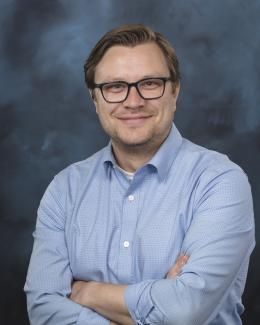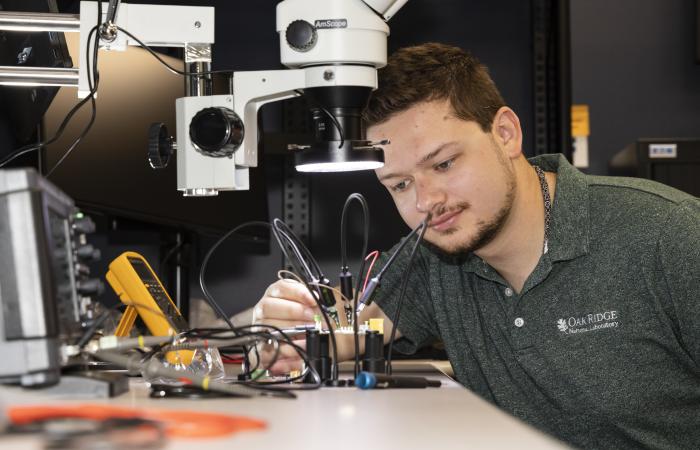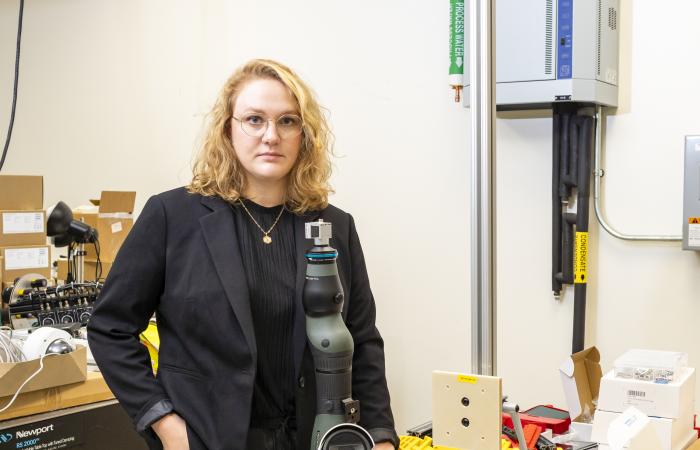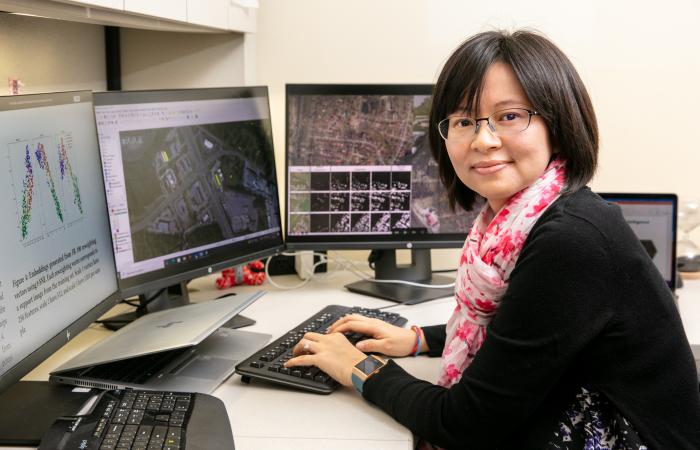For centuries, national security was a face-to-face concern, with contests playing out in fields and oceans around the world. It was a battle of military might: Who had the larger army? Who could build the most powerful weapon?
But more and more, the battle has shifted. As the world has grown more technologically advanced and interconnected, the physical limitations of adversarial engagements have diminished.
“Science and technology are becoming more and more integral to national security,” said Chuck Durant, director of Oak Ridge’s Field Intelligence Element. “The adversary keeps evolving. The technology keeps evolving. We need to keep up our own research and intelligence capabilities.”
Today, the battlefield is limitless and, often, invisible. Combating these evolving threats requires a scientific approach to national security.
“Most sciences are doing battle with natural laws, trying to understand or overcome the physical limitations of the natural world,” said Shaun Gleason, director of ORNL’s Cyber Resilience and Intelligence Division. “When you get into national security science, you’re looking at a challenge that’s very different — you’re dealing with adversaries, and our adversaries are very intelligent and dynamic.”
Recognizing this shift, ORNL established a National Security Sciences Directorate in 2018. It is structured largely around cybersecurity, nuclear security, human security and intelligence support, but as Associate Laboratory Director for National Security Sciences Moe Khaleel notes, solving today’s challenges requires more than any single scientific discipline.
“The interesting thing about national security sciences is that to solve a national security challenge, you have to bring different areas of science together,” Khaleel said. “And frankly, it’s not just science; it’s actually science, technology and analytical tradecraft — being able to use the tools of science to understand and communicate what our adversaries are doing.”
Developing the science and technology required to advance national security missions is something ORNL has done since it was created during World War II’s Manhattan Project (see “Engineers and scientists support nonproliferation efforts,” page 24.)
“The entire existence of Oak Ridge came from a national security interest,” said Budhu Bhaduri, director of the lab’s Geospatial Science and Human Security Division. “Nuclear science is something that, in the past, we have invested in because of our national security interest.”
Today, ORNL researchers are continuing the site’s Manhattan Project legacy and advancing the science of nuclear nonproliferation. But they are also looking at emerging threats, such as cyberattacks on critical infrastructure and the national security implications of climate change.
Reducing nuclear risks
Cary Crawford started his career in the nuclear industry at exactly the wrong time.
He joined DOE’s Pantex nuclear weapons plant in 1993 — right when the new, post-Cold War order resulted in a precipitous decline in weapons production. For decades, U.S. research into the nuclear fuel cycle, and the resulting scientific expertise, had been driven by the weapons program. The sudden shift in the early ’90s left a gap, and these scientific capabilities began to atrophy.
“There wasn’t much hiring after me,” said Crawford, who now leads ORNL’s Nuclear Nonproliferation Division. “So there’s a pretty hefty generational gap today in industry expertise.”
In Crawford’s division, researchers, engineers and operations specialists are delivering science and technology to reduce the risk that nuclear materials will end up in the wrong hands while enabling their secure use for peaceful applications across the world.
“Whether it’s early detection, real-time monitoring and accounting, or engineering for safe reactor operation, the science behind that is what we’re interested in,” said Jennifer Ladd-Lively, Nonproliferation Engineering Science and Technologies section head. “And we want to help move that science into practical application to better mitigate the risks.”
Looking to advance uranium science and fill the generational skills gap, ORNL is leading multiple efforts for the National Nuclear Security Administration’s Nonproliferation Stewardship Program.
The lab is building a Uranium Science and Technology Center to reestablish core fuel cycle science and technology capabilities, advancing centrifuge modeling and simulation capabilities (see “High-performance computing boosts uranium research,” page 14), and developing the next generation of nonproliferation experts. Researchers are also looking at emerging technologies to ensure the U.S. is prepared to meet future nonproliferation goals and threats.
“Up until now, the nuclear industry has been slow to adapt next-generation technologies. But now we’re looking at advanced manufacturing, artificial intelligence, high-performance computing,” said Jared Johnson, senior nonproliferation program manager. “These tools have huge, untapped potential in our industry.”
That’s both exciting and concerning. For every opportunity a new technology brings to help advance the industry, reduce costs and improve security, there’s an equal and opposite opportunity for those tools to be used nefariously.
The threats are evolving, and at the top of Crawford’s mind are cyberattacks.
“Cyber is huge because that’s the next type of warfare. With cyberattacks, you can take down entire infrastructures and destroy our ability to live the way we live,” he said. “Think about your way of life. Everything about your way of life involves electricity, water, infrastructure. And if you take down one of those elements, the impact is huge.”
Securing critical assets
Crawford isn’t the only one thinking about cyber-enabled attacks on critical infrastructure.
Cyber Resilience and Intelligence Division Director Gleason is keenly aware of the national security threats posed by society’s increasing digitization. In fact, he has a favorite analogy to explain the scope of the challenge.
Imagine you’re standing beneath Niagara Falls, with a never-ending stream of water — more than 750,000 gallons per second — rushing your way. Now imagine every drop is a bit of software code, with each bit vulnerable to hacking. Where will the code lead? What will it touch? How do we find and protect the data that matters most?
“That is, in essence, the challenge cybersecurity experts face every day,” Gleason said. “The amount of software generated around the world is mind-blowing, and it flows into so many different technologies and components, from smart devices and vehicles to manufacturing systems and the energy grid.”
At ORNL’s newly opened Cyber Science Research Facility, researchers are advancing the science of cybersecurity, leveraging artificial intelligence and high-performance computing to improve everything from cyber defense architecture to intelligence analysis.
Computer and data scientists, cybersecurity scientists, mathematicians and engineers are increasingly focused on the cyber-physical connections that make up critical national infrastructure — energy, transportation, military and manufacturing systems — where cyber-based intrusions could produce physical catastrophes with national security implications.
As the nation pushes to modernize its energy infrastructure, the challenge of maintaining a resilient power grid grows exponentially. Each new connection to the grid, from electric vehicle charging stations to smart devices, introduces a potential vulnerability point that an adversary could exploit remotely to access the broader grid infrastructure.
To improve grid security and resilience, ORNL researchers are developing tools to identify counterfeit grid components and eliminate device-based vulnerabilities (see “Strengthening cybersecurity in the energy sector,” page 20).
“We need to analyze how all these components are working together, and how that compounds functionality and vulnerability,” said Tricia Schulz, group leader for Embedded Systems Security. “Our focus is on how we understand the risks and mitigate them on these devices, especially as the grid significantly expands.”
Each new cyber-physical connection also generates new data. ORNL scientists are helping intelligence analysts visualize massive amounts of data that characterize how critical infrastructure is functioning and whether systems may be compromised. Leveraging ORNL’s data science and high-performance computing capabilities, researchers have developed programs to fuse and analyze various forms of data in real time, helping analysts more quickly detect anomalies and threats.
They’re also looking at the entities behind cyber intrusions, developing new tools and technologies to identify adversaries, understand their capabilities and thwart their attacks.
“In national security sciences, these are dynamic challenges,” Gleason said. “You solve the problem one day, and the next day the adversary has adapted and moved ahead of you.”
Advancing human security
Bhaduri, of the Geospatial Science and Human Security Division, wants to make sure the U.S. knows at all times what our adversaries are doing. In fact, he seeks the ability to continuously monitor the entire Earth and its systems — environmental, physical, human — much as a hospital monitors each patient’s vital signs. He calls it “the pulse of the planet.”
“I envision a world where anybody can wake up and say, ‘I would like to know the state of my 1 km-by-1 km land I own or care about,’” he said. “What is the temperature? What is the pressure? Is it flooded? Are there people? That’s the pulse of the planet.”
The implications are far-reaching, and they extend beyond traditional definitions of national security. Automatic detection of wildfires and other disasters, for example, could help authorities enact efficient response plans that prioritize the populations most at risk — making communities more resilient and stable.
“One of the key objectives of national security is to minimize the loss of human lives and the damage to economies, right?” Bhaduri said. “Whether that’s an active war or a battle versus diseases, resource constraints or climate disasters — they’re all relevant to national security.”
While the Cyber Resilience and Intelligence Division is securing individual grid connections and interactions at the component level, researchers in the Geospatial Science and Human Security Division are looking at the grid on a national scale.
With expertise in data science, high-performance computing and geospatial science, they are providing broad situational awareness of interdependent energy systems to support emergency response, disaster recovery and power restoration efforts — whether in response to adversarial attacks or extreme weather (see “ORNL tools help ensure energy supply,” page 16).
While this level of situational awareness helps address immediate needs, the data it generates can also help authorities predict and prevent future events.
“Our ability to constantly monitor these infrastructures in a meaningful way allows us to anticipate much better,” said Dave Page, who leads the Geographic Data Science Section. “We can use the data over a long period of time to understand consequences of what might happen and where we might see effects and impacts.”
Yet, for all their work with global satellites, massive datasets and artificial intelligence, Bhaduri’s division is ultimately focused on people. For decades, ORNL has produced LandScan, the definitive global population dataset for human dynamics and distribution modeling. LandScan has been used around the world to estimate populations at risk and aid in disaster planning and response.
“If you have a good sense of where people were at the time of an event, you have a very educated guess as to how many people may have been affected in a particular location,” said Marie Urban, Human Geography group leader at ORNL. “From there, you can adjust the level of response and assistance for the greatest impact.”
The unique integration of these capabilities and datasets — along with resources like a new, small satellite ground station and access to the world’s fastest supercomputer, ORNL’s Frontier — can significantly reduce the amount of time it takes to get from data to decisions to action.
For disaster scenarios, Bhaduri and team aim to produce meaningful information within the first 72 hours, the crucial period during which responses can save lives. That — saving lives — is their key metric.
“In the end, if we cannot really move that needle, all we have are some great sets of PowerPoint slides and a few papers,” Bhaduri said.
Confronting emerging technologies
As Gleason noted, the challenge in national security science is that there’s always someone on the other side trying to push that needle back. The adversary’s task gets easier as disruptive technologies — artificial intelligence, autonomous systems, biotechnology — become more widely available.
“In my mind, the biggest threat we are facing is the increasing proliferation of emerging technologies,” National Security Sciences Associate Laboratory Director Khaleel said. “And it’s not just proliferating to large adversarial nations; you can proliferate technologies like these everywhere and to anyone.”
To address the challenges of distributed, emerging technologies, Khaleel believes we should treat them similar to nuclear materials and take a cue from the international nonproliferation regimes established to monitor, regulate and control them.
“Cyber, for example, is a weapon, so how do you ensure that others don’t have these capabilities?” Khaleel said. “The other thing is to think about economic security. You don’t want these technologies that give the United States economic advantage to just walk out of the country.”
What’s more, Khaleel said, the U.S. must continually evolve its own capabilities to ensure we outpace our adversaries. He points to an emerging field ORNL researchers are exploring, cognitive AI, as an example.
“The nature of cyberattacks will continue to evolve. When these things evolve, we cannot just have static AI-based defense schemes. We need resilient, cognitive AI that continues to evolve with the threats.”
With its combination of historical expertise, world-class research facilities and translational science capabilities across diverse disciplines, ORNL is uniquely suited to solve the modern challenges of national security. But what really sets ORNL apart, Khaleel believes, is its people.
“From our analysts to our teams working in nonproliferation, cyber and human security, along with researchers across the lab engaged in national security missions, we have great people. I think that’s our secret in this lab; we have great people who are passionate about what they do and believe in one another.”






